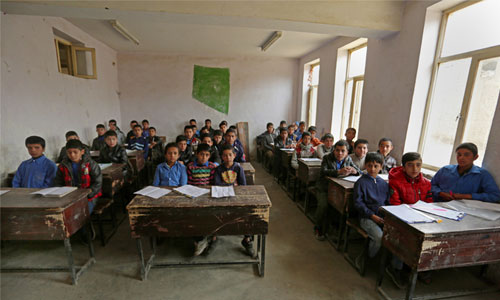This week, the Bill & Melinda Gates Foundation will release its annual Goalkeepers report card assessing progress toward the UN Sustainable Development Goals. Among the expected findings is a prediction that by 2050, nearly 90% of global poverty will be concentrated in Sub-Saharan Africa, and two-thirds of the world’s poorest people will live in just ten countries.
The ability to identify human-development hotspots – what we call “severely off-track countries” (SOTCs) – should, in theory, make it easier to apply solutions. Unfortunately, some aid agencies tend to avoid fragile states out of fear that their resources will be wasted. Currently, less than a quarter of OECD countries’ programmable aid is allocated to SOTCs.
But the perception that fragility presages failure is misplaced. With adequate planning, it is possible to implement projects that improve lives in even the riskiest places. Best of all, we know where to start: by investing more in human capital, and especially in education.
According to the Goalkeepers report, the number of children enrolled in primary school in Africa increased from 60 million in 2000 to some 250 million today, and the rate of growth was equal for boys and girls. But while more children are attending classes, school quality remains uneven. The challenge now is to ensure that all children, including those who are in school – at all grade levels – are learning the full breadth of skills they need to thrive.
To give young people the best chance of success, the two “bookends” to primary school – early childhood education and secondary education – must also be sturdy. Early childhood education prepares children for primary school by teaching cooperation, perseverance, self-control, and other essential skills. These formative years are critical for a child’s education, because, according to UNESCO, more than half of all children and adolescents worldwide never develop foundational competencies crucial to becoming life-long learners.
At the other end of the spectrum, secondary education helps adolescents prepare for the job market. To succeed at this level, students must achieve minimum proficiency in reading, math, and numerous non-cognitive skills. But even here, educational outcomes are disappointing. In low-income countries, nine out of ten young people lack basic secondary-education level proficiency across a suite of essential skills, ranging from literacy and critical thinking to mathematics, and problem solving. In Sub-Saharan Africa alone, an estimated 200 million young people (about 90% of the primary and lower secondary-school population) are not able to read basic texts.
Development specialists know that a good education is transformative for students as well as families, communities, and countries. One study from 2008 found that the quality of a country’s education system – and the cognitive abilities of its graduates – positively influences economic growth. That fact alone should be enough to convince fragile states and their donors to invest in expanding access to quality education.
But there are other, more indirect benefits, especially for women and girls. For starters, better-educated women delay pregnancy and typically have smaller families. Development experts, demographers, and education advocates recognize that in many parts of the world, female empowerment is proportionate to family size. For example, our research has found that a woman with zero years of schooling will have, on average, 4-5 more childrenthan a woman with at least 12 years of schooling.
Increasing educational opportunities for girls would also benefit the planet. The International Institute for Applied Systems Analysis has projected that if every girl in the world completed secondary education, fertility rates would drop and the global population growth would slow by as many as two billion people by 2045, and more than five billion by 2100. The deceleration would be even greater if the 214 million women worldwide who want to avoid pregnancy but cannot acquire contraception could access family-planning services. It is no coincidence that many of these women live in countries where fewer girls than boys attend school.
Taken together, schooling and family planning could translate into a 120-gigaton reduction in carbon dioxide emissions over the next three decades, as fewer people consumed fewer resources. It is no surprise that environmentalists like Paul Hawken believe that education – and educating girls in particular – is among the most effective steps the world can take to combat climate change.
The annual Goalkeepers report is a reminder issues like gender inequality, malnutrition, violence, and political instability will plague the world’s poorest people for decades to come. Among solutions, few are as effective as quality education. If fragile states and international donors directed more resources to strengthening education’s three pillars – early, primary, and secondary – the world’s SOTCs would finally have a chance to get back on track.
Home » Opinion » Education for Fragile States
Education for Fragile States
| Homi Kharas and Rebecca Winthrop

